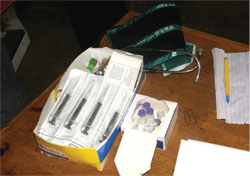Use 'Print preview' to check the number of pages and printer settings.
Print functionality varies between browsers.
Printable page generated Thursday, 20 November 2025, 12:50 AM
Health Management, Ethics and Research Module: 6. Management of Supplies at Health Post Level
Study Session 6 Management of Supplies at Health Post Level
Introduction
This study session will introduce you to some of the aspects of resource management that will be relevant to your work as a Health Extension Practitioner. You have already learned about managing your own time and performance, and that of other people in your team (i.e. human resource management) in Study Sessions 4 and 5. In this study session we will focus on resource management of the drugs and equipment needed at your Health Post.
An important aspect of your work is getting the best use out of the resources that you are in charge of. The successful performance of your healthcare activities will depend on using your resources in the most efficient way, because, obviously, limitations of resources will prevent the full attainment of your objectives. But how can you avoid resource problems from happening? This study session will equip you with the knowledge and skills to apply to resource management problems at Health Post level, so you can ensure that your healthcare activities are supported by adequate resources. We will teach you a system for estimating quantities, ordering supplies and preventing wastage that should enable your work to run smoothly.
Learning Outcomes for Study Session 6
When you have studied this session, you should be able to:
6.1 Define and use correctly all of the key words printed in bold. (SAQ 6.1)
6.2 Describe the actions you would take to maintain essential Health Post equipment and prevent breakdowns. (SAQ 6.2)
6.3 Describe how you would manage Health Post stores in order to maintain essential health services in your community and reduce wastage. (SAQ 6.3)
6.4 Explain how you would estimate quantities of drugs and other consumable supplies on the basis of rates of use. (SAQ 6.4)
6.5 Explain why it is important to educate Health Post staff, volunteers, patients and parents about the correct use of drugs and other consumable supplies issued to them. (SAQ 6.5)
6.1 What are the supplies at your Health Post?
At each Health Post and health centre there are stores of essential equipment, drugs and other supplies that you will need to use during your routine healthcare work. It would make your work very difficult if one day the things you needed were not available, so it is important to plan and manage these stores as accurately as possible. You have already learned a lot about planning, implementing and monitoring your healthcare activities (Study Sessions 3 and 4). Here we focus on a specific aspect of this process: the management of your Health Post supplies.
The standard Health Post kit containing essential equipment and other supplies was developed by the Ethiopian Federal Ministry of Health (FMOH) in 2005. These kits are of two types: Health Post Kit A and Health Post Kit B. The only difference between Kits A and B is that Health Post Kit A has a refrigerator, while Health Post Kit B has a cold box instead of a refrigerator.
There are two main types of supplies in your Health Post, referred to as non-consumables and consumables. We will look at each of these in turn.
6.1.1 Non-consumables
Non-consumables are items of equipment that can be used for years, but may eventually have to be replaced or updated. Table 6.1 shows the list of equipment issued to Health Posts by the FMOH in 2005 in Kit B, for use by Level-III Health Extension Workers. There may be local differences in the equipment issued to you and new items will be added relating to your greater responsibilities as a Level-IV Health Extension Practitioner (HEP). The list may also change in future in accordance with changing FMOH policies. But Table 6.1 will give you a good idea of what a standard equipment list for your Health Post will be like.
| Catalogue no. | Non-consumable items | No. |
|---|---|---|
| S0481053 | Thermometer, clinical, digital, 32–43oC | 2 |
| S0157000 | Steriliser, steam, 24 litre | 1 |
| S0170000 | Stove, kerosene, single-burner, pressure | 1 |
| S0141020 | Scale, electronic, mother/child, 150 kg x 100 g | 1 |
| S0145555 | Scale, infant, spring type, 25 kg x 100 g | 1 |
| S0189000 | Weighing trousers/PAC-5 | 1 |
| S0350000 | Arm, circumference insertion tape/PAC-50 Spec. for Ethiopia | 1 |
| S0101000 | Bed, labour/delivery, w/access | 1 |
| S0630000 | Flashlight, pre-focused | 1 |
| S1802212 | Battery, dry cell, alkaline, D, 1.5 Volt | 2 |
| S9910005 | Surgical instruments, dressing, SET | 1 |
| S9902218 | Midwifery kit | 2 |
| S0334700 | Jug, measuring, 1 litre | 1 |
| S0237000 | Bowl, stainless steel, 180 ml | 4 |
| S9975020 | First Aid Kit A | 1 |
| U439410 | Membrane micro-filter, water, small scale, 1EA | 1 |
| 0010089 | Vaccine carrier, large, capacity 1.5–3.0 litre, PIS Ref:E4/83-M | 1 |
| 0010015 | Vaccine cold box: Blow Kings Model, PIS E4/76-M | 1 |
In addition, your community members will provide some simple furniture for your Health Post, such as a table, chairs, shelves, etc., like those shown in Figure 6.1.
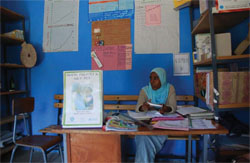
6.1.2 Consumables
Consumables are items that are used within a short period of time, so they need to be regularly replaced. They include all the medicines, drugs, vitamin supplements and infusion fluids (for intravenous use) that you will be trained to give to your patients in specific circumstances, and also the disposable (single-use) items of equipment and other supplies. Table 6.2 shows the list of consumables issued to Health Posts by the FMOH in 2005 in Kit B, for use by Level-III Health Extension Workers. Remember that there may be local differences in what is issued to you and new items will be added relating to your greater responsibilities as a Level-IV Health Extension Practitioner.
| Catalog no. | Consumable items | No. |
|---|---|---|
| S1555965 | Paracetamol 500 mg tabs, PACK, 1000 | 1 |
| S1550020 | Ferrous salt + folic acid 60 + 0.4 mg tablets, PACK, 1000 | 16 |
| S1561121 | Oral rehydration salts (ORS), new formula, 1 litre, BOX, 1000 | 1 |
| S1555370 | Albendazole 400 mg tablets/PACK,100 | 10 |
| S1553105 | Povidone iodine solution 10%, BOTTLE, 500 ml | 5 |
| S1531505 | Chlorhexidine conc. sol. 5%, BOTTLE, 1000 ml | 2 |
| S1510000 | Tetracycline eye ointment 1%, TUBE, 5 g | 10 |
| S0330102 | Gloves, gynaecological, size 7.5, sterile, disposable, pairs | 100 |
| S0566005 | Tape umbilical, 3 mm wide × 50 m long, non-sterile | 4 |
| S0319000 | Extractor, mucus, 20 ml, sterile, disposable | 50 |
| S0523055 | Compress, gauze, 10 × 10 cm, sterile, PACK, 5 | 60 |
| S0523005 | Compress, gauze, 10 × 10 cm squares, non-sterile, PACK, 100 | 5 |
| S0503010 | Tape, adhesive, ZO (zinc oxide), 2.5 cm wide × 5 m long | 12 |
| S0519600 | Cotton wool, 500 g roll, non-sterile | 10 |
| S552000 | Soap, toilet, bar, approx. 110 g, wrapped | 36 |
| S1588350 | Water purification tablets (NaDCC) 8.5 mg tablets, PACK, 100 | 10 |
| S0330011 | Gloves, examination, latex, medium size, disposable, BOX, 100 | 5 |
Note, that as a Level-IV Health Extension Practitioner, when your training is complete you will also be issued with additional consumable items for your Health Post. These higher-level consumables include the oral antibiotic amoxycillin, the injectable drug oxytocin (to help the uterus contract after childbirth), sterile bags of intravenous infusion fluids, and the intravenous tubing, cannulae and other equipment for pre-referral treatment of haemorrhage (e.g. following childbirth or an injury causing excessive bleeding), and the catheter and special tubing for draining urine from the bladder in cases of obstruction during labour and delivery.
Look closely at Figure 6.2. Make a list of all the health-related equipment that you can see. Which of these items are consumables and which are non-consumables?
The disposable syringes, the vials on the table and the pen and papers are consumable items. The blood pressure apparatus, stethoscope and the table are non-consumable equipment.
6.2 Management of equipment
As a Level-IV Health Extension Practitioner you will be involved in the maintenance of non-consumable equipment in the Health Post, i.e. keeping it in good working condition. What skills do you need in order to fulfil this responsibility?
6.2.1 The importance of good maintenance
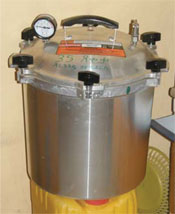
All equipment must be cleaned, inspected and kept in good order. Defects must be identified and reported to the woreda Health Office immediately. Equipment must always be returned to its correct place after use.
Can you suggest any reasons for maintaining equipment efficiently? Look again at the list in Table 6.1 to help you think about what could go wrong if the items of Health Post equipment are not in good working order when needed?
You may have thought of:
- Drugs, vaccines and other consumables that need to be kept cold will be unusable if the refrigerator breaks down or the cold box is damaged.
- If the steam steriliser (Figure 6.3) is not working properly, infection could result from the use of dirty instruments from the midwifery kit.
- If the torch and battery are not properly maintained, you may not be able to see the client adequately if you are called to a house that has no electricity or kerosene lamps.
- Dirty or damp equipment deteriorates more rapidly than equipment that is kept clean and dry – poor maintenance leads to more breakdowns; equipment that is well cared for and returned clean and in good order to its correct place after use will last longer and has to be replaced less often.
The maintenance of all equipment is essential to ensure that it functions correctly and efficiently. Simple maintenance of equipment may be carried out by you at Health Post level, but in most cases trained or assigned technicians or engineers will be sent to the Health Post by the woreda Health Office, to maintain equipment such as the refrigerator or steriliser if they break down.
6.2.2 Using an inspection checklist and inspection schedule
How often equipment should be checked depends on its purpose and rate of usage. Long-lasting equipment such as the labour/delivery bed, table and chairs may be checked only once a year. Equipment and machinery that is liable to break down (e.g. refrigerator, steam steriliser) need regular and more frequent check-ups.
It is more efficient to carry out or request maintenance of equipment on a preventative basis, according to your inspection schedule, rather than after a breakdown. A major breakdown can be a sign that the maintenance and servicing programmes have failed.
In summary, a good Health Extension Practitioner managing a Health Post takes care of equipment by instructing and motivating her team of Health Extension Workers and community volunteers to feel responsible for the equipment they use, and for inspecting and maintaining it according to the agreed schedule.
In the next section, we consider your responsibilities for ordering supplies when needed, recording and monitoring stocks efficiently, storing them safely, and controlling their use.
6.3 Ordering and controlling supplies
This section applies particularly to consumable items, which are frequently used in your healthcare work and therefore need to be restocked regularly (Figure 6.4). Ordering supplies for the Health Post must be done efficiently to ensure that you do not run out of essential items and to avoid wastage due to ordering too much. This is particularly important in relation to items that have a limited lifespan and must be used before a certain date (a subject we return to later).
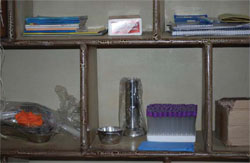
6.3.1 Ordering, recording and controlling supplies
You should include the following information when you order supplies from the woreda Health Office:
- List the number of items you require, based on past use and estimates of current use.
- You may also need to order replacements for equipment, e.g. a new thermometer if the one originally issued has broken or been lost.
- State the exact type of each item, e.g. torch battery, 1.5 volt.
- State the quantity of each item, e.g. kerosene, 20 litres per month.
Each item delivered to the Health Post (whether consumable or non-consumable) will be accompanied by either an invoice or a delivery note. You must place invoices and delivery notes in separate files normally kept for that purpose and labelled appropriately. Receipt of the new item should be entered in the stock book (Table 6.3). After the supplies have been ordered, received and recorded in the stock book, they may be issued for use when needed and the balance remaining in stock recorded in the book (see the right-hand columns in Table 6.3).
| Item | Date received | Received from | Invoice number | Quantity received | Quantity issued, date | Balance in stock |
|---|---|---|---|---|---|---|
| Cotton wool rolls, non-sterile | 1/4/2010 | Woreda store | 456 | 10 rolls | 12 rolls | |
| 2 rolls 5/4/2010 | 10 rolls | |||||
| 4 rolls 28/4/2010 | 6 rolls |
When you are first deployed to a Health Post, you should make an inventory of the consumables and equipment (Figure 6.5). An inventory is a list of items that are kept in your Health Post – the name of each piece of equipment or consumable item and the number in stock (see Tables 6.1 and 6.2 for examples). Each Health Post should keep an inventory of its supplies and new items are added to the list as they arrive.
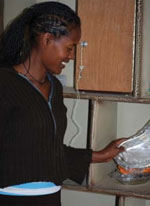
6.3.2 Detecting discrepancies and explaining them
A discrepancy is a difference between what is reported and what is found. For example, imagine that 18 bottles of paracetamol syrup (Figure 6.6) were issued to a Health Post and entered into the stock register. After one month the Health Extension Worker took an inventory and found that she had issued nine bottles, but only five bottles remained. Four bottles were missing. This is a discrepancy in the stores.
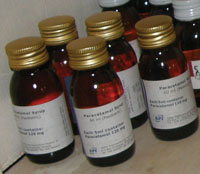
Can you think of some possible explanations for this discrepancy?
You may have thought of several reasons, including:
- Perhaps the bottles were badly packed and were broken or lost.
- One of the Health Post staff may have been careless and broken the missing bottles and not reported it.
- The missing bottles may have been stolen.
If you find a discrepancy when you check your stores, it is important that you try to identify the cause and take appropriate actions.
Suppose you find out that a volunteer at the Health Post has broken the bottles, but was afraid to report it to you. What should you do? (Think back to Study Session 5.)
It is your responsibility to manage and improve the performance of this individual, by first discussing with them the circumstances in which the bottles were broken, and advising on how to prevent such an accident from happening again. Then you would discuss the reasons for reporting the breakage and encourage the volunteer to be honest with you about any such incident in the future. Remember to praise the person for admitting what happened and keep his or her performance under closer observation in future appraisals.
6.3.3 Ordering supplies to avoid wastage
All drugs, vaccines, vitamins, infusion fluids (etc.) are unsafe to use if they pass their expiry date, i.e. the date printed on the package or bottle when the item must either be used or discarded. Therefore, efficient ordering and stock control is essential to avoid wastage. The same principles apply to ordering all the consumable items in your stock – for example, rolls of cotton wool, vials of vaccine or a box of surgical gloves.
You should be able to predict with reasonable accuracy the quantity of each consumable item that has to be ordered. The purpose is to ensure that your Health Post has adequate supplies to deliver the treatments and other health services that you have been trained to give to people in your community. Consider the following example of how you would estimate the quantity to order of a particular drug.
If you are treating two new adult cases every day for parasites in the intestines, and the standard treatment in an adult is a total of six 100 mg tablets of mebendazole, how many tablets will you need for a three month (90 day) period?
The calculation is as follows:
2 (patients) x 6 (tablets) x 90 (days) = 1,080.
So you will need 1,080 tablets of mebendazole for a three-month period.
Calculations like the one above will enable you to estimate the ordering requirements for all the supplies in your stores, based on usage rates.
More detailed instructions on estimating the quantity required for vaccines, based on their expiry date and rate of usage, can be found in the Module on Immunization.
6.4 Management of pharmaceutical supplies in your Health Post store
Pharmaceutical is pronounced ‘farm-ah-syoo-tik-al’.
In this section, we are using the term pharmaceutical supplies to include all the drugs used for the treatment of defined health conditions or problems (e.g. paracetamol, mebendazole, Coartem, etc.), the vaccines used in the Expanded Programme on Immunization (EPI), and the other tablets or liquids that you may prescribe for patients, such as vitamins, iron supplements and infusion fluids. These items are ordered from the pharmacy at the nearby Health Centre, or from the woreda Health Office.
6.4.1 Why pharmaceutical supplies must be managed carefully
Drugs, vaccines and other pharmaceutical supplies are a special resource that you need to manage carefully for many reasons, including the following:
- Some drugs (e.g. antibiotics) are expensive resources and must be used wisely.
- All pharmaceutical supplies can expire (i.e. pass their ‘use-by’ date), so ordering and stock control is essential to avoid wastage.
- Some drugs (e.g. oxytocin) and all vaccines need to be stored at the right temperature, otherwise they will become useless.
Most vaccines must be stored at between 2ºC to 8ºC.
- Furthermore, most drugs are much-wanted items and you will have to ensure that good security is in place at all times to avoid theft of your supplies.
Your pharmaceutical supplies at the Health Post should be properly managed to ensure that they are available when and where needed. You should calculate the remaining balance and check against what remains on your shelf before requesting more drugs or other pharmaceutical supplies.
You must also consult and get support from the nearby Health Centre or woreda Health Office for safe ways of discarding expired drugs, or drugs that have been dispensed to patients but remained unused.
Can you think of some common reasons for wastage of pharmaceutical supplies?
You may have identified some of the following reasons that you think could be investigated and perhaps improved:
- Improper selection of drugs and other supplies, i.e. the wrong items are ordered.
- Supplies are ordered at the wrong time or in the wrong amounts.
- Damage, loss or theft of supplies occurs at any stage during transportation from the manufacturer to the Health Post.
- Spoilage of supplies by wrong storage practices, e.g. failing to refrigerate drugs and vaccines that must be kept cold.
- Poor explanation to the patient during dispensing, so the patient takes the drug or supplement incorrectly.
6.4.2 Storing pharmaceutical supplies safely
You should store pharmaceutical supplies in an orderly manner and record them in the stock book as soon as you collect them or receive them. Drugs should be kept in a cupboard, dry and cool and away from direct sunlight (Figure 6.7). Keep tablets in airtight tins or jars and clearly label each container. Clearly mark all containers with drugs that will expire this year. Vaccines should always be kept in the refrigerator.
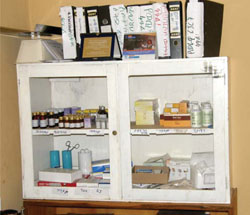
When storing and using drugs and other pharmaceutical supplies, remember the FIFO and FEFO principles:
- FIFO: First-In, First-Out (first use the drug that first went into the cupboard or refrigerator)
- FEFO: First-Expired, First-Out (first use the drug that will expire first).
6.4.3 Monitoring the use of pharmaceutical supplies
Efficient monitoring enables you to:
- Notice when stocks need re-ordering.
- Check drug use against patient treatment.
- Become rapidly aware of discrepancies in drug treatment.
Discrepancies in drug usage are identified in the same way as discrepancies in equipment stocks. The amount of drug expected to be used is compared with the amount actually used. If there is a significant difference, this is a discrepancy.
Controlling life-saving drugs and fluids
Sometimes a patient’s condition becomes severe or critical so suddenly that only the immediate use of certain drugs or fluids can save his or her life. It is very important that such supplies are always in stock. The absence of these supplies in an emergency may result in a patient dying. This is an unnecessary tragedy and a failure of health service management. To avoid this it is essential to:
- Make a list of life-saving drugs and fluids.
- Place them together on one shelf in the drugs cupboard or the refrigerator.
- Check the shelf frequently or whenever supplies are issued.
- Order a new supply when stocks are depleted by half.
An emergency supplies list for a rural Health Post managed by a Level-IV Health Extension Practitioner might include:
- Normal saline solution (given intravenously through a vein) for pre-referral treatment of severe dehydration or haemorrhage.
- Oxytocin (intramuscular injection) for pre-referral treatment of abnormal bleeding after delivery (postpartum haemorrhage).
- Rectal artesunate or intramuscular injection of artemether lumefantrine for pre-referral treatment of severe malaria.
- Amoxicillin or co-trimoxazole antibiotics for pre-referral treatment of severe pneumonia.
- Paracetamol for pre-referral treatment of severe pain.
6.5 Education about drugs and other medications
6.5.1 Education for the Health Post team
It is very important that all your staff and volunteers in the Health Post are educated on the importance and use of drugs, as well as the way to handle them safely. In your staff meetings, you should regularly discuss standard drug treatments for common conditions that you are supposed to manage in Health Posts. Make sure that the common standard treatments are clearly displayed on wallboards, for example, the standard treatment guidelines for malaria with the anti-malaria drug, Coartem. Refer to the standard drug lists for your Health Post. Each Health Post should constantly work on standard drug lists and standard treatment guidelines.
Malaria treatment at Health Post level is covered in the Communicable Diseases Module, Part 1.
6.5.2 Special education for patients and parents
Patients with tuberculosis, leprosy or HIV/AIDS who have to take drugs for many months need a great deal of explanation and encouragement. They must continue to take tablets even when they feel better, in case the disease becomes active again. Parents need to be educated about treatments for their children, for example, to kill intestinal worms, and also about bringing their young children regularly for vitamin A supplements.
Patients and parents need to be educated about taking drugs or other medications at the correct time (Figure 6.8). You should also inform them of any special precautions, such as advising pregnant women to take iron tablets with food to reduce the risk of nausea.
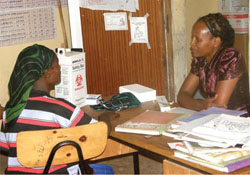
It is your responsibility to ensure that all your patients are fully informed about their treatment and to help them to comply with treatment that has been prescribed for them – either by you or by doctors at the health centre or hospital. Failure of a healthworker to educate patients about essential information regarding their health and treatment is unethical behaviour. In the next three study sessions, we turn to the important subject of ethics in healthcare.
Summary of Study Session 6
In Study Session 6, you have learned that:
- Consumables and non-consumable equipment and supplies are provided for Health Posts according to lists published by the Ethiopian Federal Ministry of Health.
- Health Post staff are responsible for ensuring that non-consumable equipment (e.g. refrigerator, steriliser) is regularly maintained and that breakdowns are reported quickly.
- Health Post staff are responsible for all aspects of the management of consumables, including ordering stocks to ensure essential services are maintained and to minimise wastage, recording when items are issued so that usage rates can be calculated, and ensuring correct storage to preserve the efficacy of drugs and other medications.
- Effective stock control involves regular inspection of supplies and taking an inventory to detect any discrepancies between the expected stock levels and the actual stock levels. Reasons for any discrepancies should be investigated and corrective action should be taken.
- Drugs and other medications should be used according to the FIFO (first-in, first-out) and FEFO (first expired, first-out) principles to avoid wastage.
- Special attention should be given to stocking adequate supplies of life-saving drugs and intravenous fluids.
- Health Post staff, volunteers and all patients and parents of child-patients should be educated about the standard treatment guidelines and how to take medications correctly.
Self-Assessment Questions (SAQs) for Study Session 6
Now that you have completed this study session, you can assess how well you have achieved its Learning Outcomes by answering these questions. Write your answers in your Study Diary and discuss them with your Tutor at the next Study Support Meeting. You can check your answers with the Notes on the Self-Assessment Questions at the end of this Module.
SAQ 6.1 (tests Learning Outcome 6.1)
Which of the following items is consumable and which is non-consumable?
- a.Antiseptic wipes
- b.Oral polio vaccine
- c.Thermometer
- d.Stethoscope
- e.Paracetamol syrup
- f.Fetoscope
Answer
a. Antiseptic wipes, b. Oral polio vaccine and e. Paracetamol syrup are all consumable items.
c. Thermometer, d. Stethoscope and f. Fetoscope are non-consumable items.
SAQ 6.2 (tests Learning Outcome 6.2)
During a Friday vaccination session, the Health Extension Worker found that one of the ice packs in the vaccine carrier was leaking and the foam pad became wet. After the session was over, she left the vaccine carrier on the floor of the Health Post with the lid closed and went home for the weekend. What problem could result from her actions? What should she have done?
Answer
The vaccine carrier and the foam pad could become mouldy because they were left wet and enclosed for at least two days. This could mean that the vaccine carrier is not safe to use for the next vaccination session. The Health Extension Worker should have dried the vaccine carrier and foam pad before she went home, and left them with the lid open so the air can circulate to evaporate any remaining moisture.
SAQ 6.3 (tests Learning Outcome 6.3)
Make a list of what actions are expected from you as a Health Extension Practitioner in managing stocks of drugs and other pharmaceutical supplies at Health Post level.
Answer
You are expected to know how to do the following in order to manage drug stocks and other pharmaceutical supplies at Health Post level:
- Estimating quantities of drugs required, based on usage rates.
- Applying the FIFO and FEFO principles in storing and using drugs.
- Monitoring the use of drugs, checking drug use against patient treatment and identifying discrepancies in drug treatment.
- Making an inventory, identifying the common reasons for wastage of drugs and finding solutions for any problems.
- Estimating when to reorder drugs in order to maintain essential health services and minimise wastage.
- Controlling the presence of life-saving drugs and fluids in your stocks at all times.
SAQ 6.4 (tests Learning Outcome 6.4)
If on average you are treating five adults per day for malaria and the standard treatment in an adult is a total of 12 tablets of Coartem, how many tablets will you need for a three-month (90-day) period?
Answer
The calculation is as follows:
5 (patients) x 12 (tablets) x 90 (days) = 5,400. So you will need 5,400 tablets of Coartem for a three month period.
SAQ 6.5 (tests Learning Outcome 6.5)
If you do not educate patients or parents of child-patients carefully about their drug treatment, what problems could arise?
Answer
If the education you give is inadequate, patients could fail to take their drugs correctly, e.g. they may take too many tablets or not enough, or take them in the wrong dosages, or stop taking them too soon, etc. Their illness may not be treated effectively, or they may suffer side-effects from taking too many tablets. In the most extreme cases, the patient could die because the information about the treatment was not clearly explained and was not understood.
